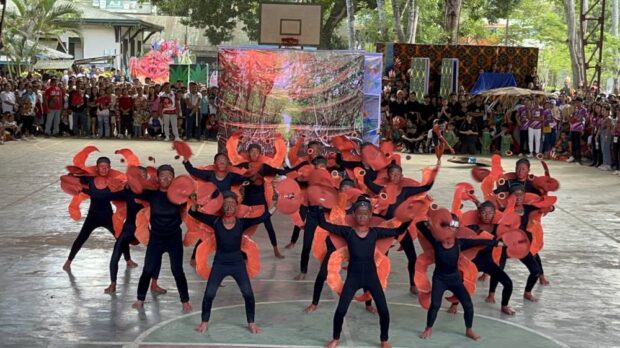Crab fest in Zamboanga seen to revive ‘dying’ industry
ABOUT CRABS In this photo taken on Feb. 23, students in Zamboanga City’s Barangay Vitali, through a street dance, depict the life of residents whose income depend on aquaculture. Crabs and
other crustaceans are the main source of income in Vitali. —JULIE ALIPALA
ZAMBOANGA CITY—For half a century, Barangay Vitali, about 70 kilometers from the city proper here, has been known as a source of first class cultured king crabs, prawns and other shelled products.
Dr. Kier Dela Calzada, administrator of the Zamboanga Peninsula Polytechnic State University (ZPPSU)-Vitali Extension, recalled how the stretch of national highway in the village used to thrive with small stores selling crabs, prawns and milkfish.
“A fresh catch in the morning easily sold out before the day ended,” he said.
But in the early part of 2010, the vibrant image of seafood covering the highway as one passed through this village drastically changed when the villagers observed colorful spots on their crabs and prawns. The spots were caused by a crustacean’s disease that badly hit all crab and prawn raisers here, recalled Mike Alavar, a former city councilor whose family owned the famous Alavar Seafoods House here.
Now, villagers felt the pressing need to revive the dying aquaculture industry before Vitali could easily end up buying king crabs from neighboring provinces.
‘Dying to be known’
On Feb. 23, the village celebrated its first Cangrejo (crab) Festival intended to revive the dying industry and draw attention to Vitali as the source of first class crabs, said Dela Calzada, who organized the event.
He wanted to make the festival bigger in the succeeding years so it would included in the city’s calendar during the Zamboanga Hermosa Festival, also known as Fiesta Pilar in honor of the city’s patron saint Nuestra Señora del Pilar, celebrated every Oct. 12.
READ: World street food festival: Try ’em all
“We support the city’s active involvement in promoting sardines, but (the industry) all come from big investors. We have our own crabs, prawns, talaba (oysters) and milkfish, our industry that is dying to be known and promoted too,” he said.
With a population of 10,716 based on the 2020 census, Vitali used to be Zamboanga city’s pride, harvesting almost five tons of crabs and crustaceans a month. Most of the harvest used to go to the markets in the National Capital Region, supplying five star hotels and restaurants in Metro Manila and other big cities.
But harvests drastically dropped from five tons a month to only four tons in a year when the crustacean’s disease struck in 2010, with most aquafarmers unable to recover from their losses
Edward Falcasantos, who was a financier of fishpond operators, lamented the lack of support from the local governments and the increasing ravages brought about by climate change.
“We used to have more 1,000 fish pond operators and tank owners here, now there are only about a hundred, so the harvest have gone down drastically,” said Falcasantos, who also used to operate a fish pond that got hit by the disease. “Our business that I ran for more than 30 years was gone and now I ended up as a buyer-seller of prawns,” Falcasantos said. INQ
